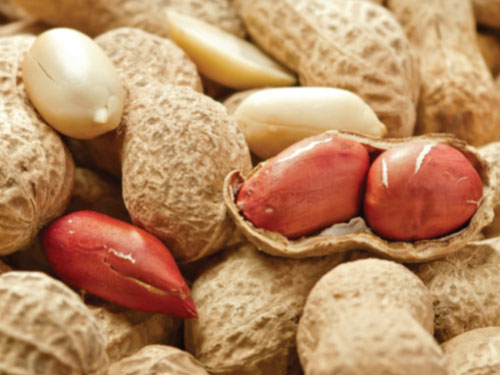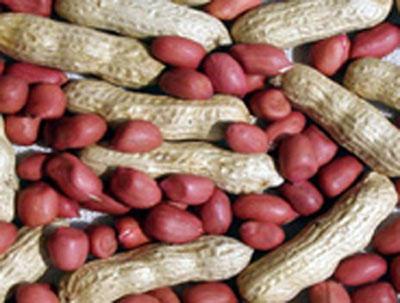
Learning Download: How to Grow Peanuts
From Seed to Harvest: A guide to growing peanuts.
Considered a healthy fat, peanuts are a staple in the pantry for snacks and can be eaten raw or roasted. In addition to monounsaturated fats, peanuts are rich in copper, manganese, vitamin b3 and more. Often looped in with the nut family, the peanut is actually a legume, related to peas and beans. Peanuts can grow in various places, such as the garden or a container pot if it is large enough. Peanuts grow underground, different form most nuts that grow on trees.
To plant:
Similar to planting a garlic clove to grow a garlic plant, the actual peanut can be planted in the garden. Although it is possible to plant an unroasted peanut from the grocery store and have it turn into a plant, gardeners will have better luck if purchasing the peanuts from a seed company. Peanuts are commonly grown in southern climates as they are a warm weather crop, but they can grow in northern areas as well. If planting in a northern climate, choose an early-maturing variety to grow.
If purchased form a seed company, peanut seeds should still be in a shell. The peanuts must be shelled prior to planting. Since they have a longer growing season, peanuts can be started indoors three to four weeks before the last frost date and transplanted to the garden a week or two after the last frost date.
Prior to planting, dig the soil at least 5 inches deep to loosen the soil, as that makes space for the peanut roots when they can begin to grow.
When planting in the garden, plant the seeds 10 inches apart and 2 inches deep, placing two or three seeds in each spot. For those growing in a northern climate, planting the peanuts on a south-facing slope may aid in their growth.
To grow:
Peanuts require full sun and frequent watering, and they do best in a sandier soil. They take up to 140 days to harvest. Once they sprout, thin the peanut plants to one per every 10 inches. Since peanut roots are very delicate, don’t weed roughly around the plants. Once the plants are 6 inches tall, cultivate around them to make the soil easier for the pegs to grow into. Add a layer of mulch to keep the weeds down and retain moisture.
To harvest:
Peanut plants can produce up to 50 peanuts per plant. The plant will begin to yellow and wilt when the peanuts are ready to harvest. Harvest them before the first fall frost.
To harvest, pull the entire plant and hang upside down in a warm place for up to two weeks. This allows the peanuts to cure. After the two weeks, pull the peanuts off the plant and then continue drying them for two more weeks.
What peanuts crave:
Although not necessary, gardeners can fertilize the peanut plants. If choosing to fertilize, use a low-nitrogen treatment. Once the plants lower, you can treat again with a calcium-rich fertilizer which will aid in nut formation.
Where to buy peanut seeds:
You can find different varietals of peanut seeds, including a Spanish variety, which is better for northern climates, at Urban Farmer.
Learning Download: Common pests and diseases: Peanuts
Common pests and diseases: Peanuts
When growing vegetables, it is always exciting to care for the plant throughout its growing phase and then harvest it for delicious recipes later on, but one thing to watch out for is pests and diseases. Different plants are susceptible to different types of pests and diseases, and it is important to make yourself aware so you can keep a watchful eye and also take any preventative methods to keep your plants safe throughout their lifespan.
Peanuts can fall victim to several pests and diseases.
Pests:
Some common pests affecting peanuts include armyworms, thrips and the velvetbean caterpillar.
Armyworms will cause singular or multiple closely grouped holes in the foliage of the plant. Apply Bacillus thuringiensis and encourage natural enemies.
Thrips will create discolored leaves and scarring, and affected plants may look silver in color. To prevent this, don’t plant near grain fields. Overhead watering may help reduce the thrips. Apply insecticides once you identify the damage as that of a thrip.
Onion maggots will cause seedlings to be stunted or wilt.
The velevetbean caterpillar’s larvae will cause damage to the plant by eating holes in the leaves. Older larvae skeletonize the leaves and the later-stage larvae eats the rest of the leaf. Moths will lay the eggs on the undersides of the leaves. To prevent these larvae, encourage natural predators and utilize either early or late crop planting to avoid insect infestation.
Diseases:
Some of the common diseases affecting peanuts include Botrytis blight, charcoal rot, early leaf spot and more.
Botrytis blight causes the plant to show numerous spots on the upper parts of the leaves, and the entire plant or large portions may wilt and then die. The plant’s pods and stems may become covered in fungal sclerotia. This disease will emerge in wet weather and high temperatures. To prevent this disease, plant early to avoid frost and apply the appropriate fungicides.
Charcoal rot causes the plant to have water-soaked lesions on the stems of seedlings close to the soil line, and if the lesions girdle the stem, the plants will wilt and die. To prevent this disease, practice crop rotation and properly water and fertilize your plants.
Early leaf spot causes the plant to show chlorotic flecks on the leaf petioles, which can enlarge and become dark. This disease is more likely to emerge in high humidity and warm temperatures. It is more likely to spread if there is prolonged leaf wetness. To prevent this disease, plow crop debris into the soil after the harvest.


